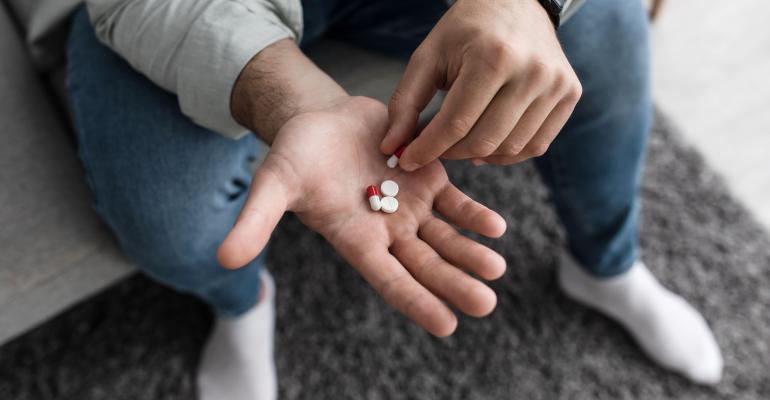Why Construction Companies Should Have Opioid-Reversal Drugs On-Site
Most industry firms have no-tolerance illegal drug-use policies, but experts say they need these over-the-counter nasal sprays to save lives.

Construction companies don’t tolerate illegal drug use by staff and others, but employees still take opioids and other narcotics before arriving at or while on a jobsite or in the office. That’s why contractors need to stock an opioid-reversal drug and know how to administer it to save lives, according to two safety experts who regularly consult with contractors.
“Everyone is impacted by overdoses in the workplace,” said Janice Hartgens, vice president of Respond Ready Workplace. “One pill can kill. They can get one pill that is laced with fentanyl, and they don’t know it.”
Fentanyl is a highly toxic opioid drug that is similar to morphine but 50 to 100 times more potent, according to the National Institute on Drug Abuse.
Hartgens, a registered nurse, and Mandi Kime, director of safety for the Associated General Contractors of Washington, unpacked opioid misuse in construction as well as things contractors should know about Narcan, a opioid-reversal drug, including how it works, where to obtain the life-saving drug, policies and procedures for responding to an opioid overdose and more during a recent AGC webinar.
In March, the U.S. Food and Drug Administration approved the first over-the-counter opioid-reversal drug, naloxone, and specifically, the nasal-spray brand Narcan. Since then, Narcan has become more widely available to contractors and other businesses, the women said.
The construction, manufacturing and transportation industries are most impacted by opioid use. According to the National Safety Council, from 2011-2021, unintentional drug overdoses rose by more than 500% and accounted for 9% of all workplace deaths, Hartgens said.
But drug poisoning deaths are preventable, and Narcan is one resource available, Hartgens said. Slightly more than 60% of people with a substance abuse disorder are in the workforce, and one in 12 people have an untreated substance abuse disorder, she said.
But she added: “Employers don’t feel they are equipped to handle what’s happening with opioids in the workplace.”
“Narcan on construction sites … is lagging,” she said later in the webinar. “We need to prove Narcan is working in the workplace, and it is saving lives.”
Why overdoses are growing more deadly
Kime said the construction industry is experiencing the “fourth wave” of illegal drug use because laboratory-made synthetic opioids, which act on the same targets in the brain as natural opioids, now are widely available.
There are four things construction companies must do to counteract the growing problem among their workers:
Reduce stigma surrounding drug use.
Manage workers’ chronic pain.
Build a drug-recovery-friendly workplace. “You must do this so they feel comfortable coming forward,” Kime said.
Support a robust approach to dealing workers’ drug use, including having opioid-reversal drugs available on jobsites and in the office.
Besides saving lives, the women said there are business reasons for these policies and programs. “In construction, we have a challenge finding and retaining skilled workers,” she said. “Having programs with (opioid-reversal drugs) retains them.”
They also said that firms can easily administer Narcan training alongside regular CPR training.
How opioid-reversal drugs work
Narcan temporarily stops the opioid in the person’s system and gets them breathing again. It has been shown to be safe, effective and easy to administer. Hartgens said it effects only someone who is experiencing the effects of an opioid overdose and will not harm those who don’t have opioids in their blood stream.
“You do not have to worry about (Narcan) interacting with other medications while they are down and not breathing,” she said.
Once the anti-overdose drug is administered, contact emergency services immediately, she said.
“Some people do refuse treatment, but you need to make sure medical services are on the way, and stay with them until they arrive.”
The women said that it may take more than one dose for the treatment to work. If the person does not arouse in two to three minutes, give another dose. The opioid-reversal drug will stay in the person’s system for 30 to 90 minutes—enough time for medical professionals to arrive and help, they said.
The person who overdosed may have multiple illegal substances in their system, but Narcan works only on opioids, Hartgens said. “It won’t work on the tranq but will on the fentanyl. Hopefully that will get them breathing until the medical help gets there.”
Tranq is the street name for Xylazine, is a central nervous system depressant that can cause drowsiness and slow breathing, heart rate and blood pressure. It’s used by veterinarians.
When the person wakes up after receiving an opioid-reversal drug, they may be disoriented and confused, Hartgens said. Remove any hazards and tell them what happened. Monitor the person while you make sure they don’t stop breathing again.
Narcan nasal spray has a three-year shelf life, Hartgen said. Narcan should be stored at room temperature and avoid being stored in places above 104 degrees or below 32 degrees.
Opioid reversal drugs are available through pharmacies, government agencies and other organizations, often at little or no cost, the women said.
All 50 states have naloxone access laws, and every state allows for it to be sold without a prescription, they added.
Other important steps to consider
Besides having opioid-reversal drugs on hand, construction companies need to tamp down their no-tolerance policies.
“Stigma is something we have to continue to battle against ... that keep people from wanting to seek help,” Hartgens said. “We need continued work with employers to show that people in recovery can be wonderful employees.”
The women also said it’s important for companies to supply workers in the male-dominated construction field with mental health resources.
“If they are suffering from a substance abuse problem, they are often dealing with an underlying mental health issue,” Kime said.
The pair recommended evaluating your company’s employee assistance program for resources and becoming aware of local treatment programs.
“Have tools ready so you can refer them,” Kime said. “Show them all the ways you have to help them get better.” And most important, she added: “Say we want you to get better.”
About the Author(s)
You May Also Like




